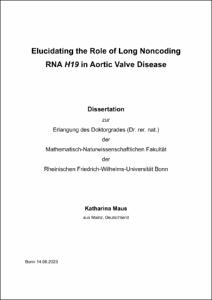Maus, Katharina: Elucidating the Role of Long Noncoding RNA H19 in Aortic Valve Disease. - Bonn, 2024. - Dissertation, Rheinische Friedrich-Wilhelms-Universität Bonn.
Online-Ausgabe in bonndoc: https://nbn-resolving.org/urn:nbn:de:hbz:5-74277
Online-Ausgabe in bonndoc: https://nbn-resolving.org/urn:nbn:de:hbz:5-74277
@phdthesis{handle:20.500.11811/11297,
urn: https://nbn-resolving.org/urn:nbn:de:hbz:5-74277,
author = {{Katharina Maus}},
title = {Elucidating the Role of Long Noncoding RNA H19 in Aortic Valve Disease},
school = {Rheinische Friedrich-Wilhelms-Universität Bonn},
year = 2024,
month = feb,
note = {Cardiovascular diseases (CVDs) are the leading cause of mortality worldwide and continue to be a major global health concern. Among various types of CVDs, calcific aortic valve disease (CAVD) has garnered significant attention. CAVD is a chronic condition characterized by fibrosis and calcification of the aortic valve tissue, ultimately leading to the development of aortic valve stenosis (AVS). AVS is characterized by impaired valve function and disrupted blood flow from the heart to the aorta. It is the most prevalent heart valve disease in the elderly population. Understanding the molecular mechanisms underlying the development and progression of AVS is crucial for the development of effective diagnostic tools and treatments. On the molecular level, AVS involves diverse disease-driving factors, including endothelial to mesenchymal transition (EndMT) of valvular endothelial cells (VECs) and the osteogenic differentiation of valvular interstitial cells (VICs). Emerging research has also highlighted the crucial role of noncoding RNAs, such as microRNAs (miRs) and long noncoding RNAs (lncRNAs), as critical regulators of AVS. However, the current understanding of the molecular regulation of AVS remains limited.
The here-presented doctoral thesis aims to investigate the role of lncRNA H19 in AVS, with a specific focus on its involvement in EndMT in VECs and osteogenic differentiation in VICs. The study revealed that H19 was downregulated during EndMT induction in VECs and upregulated after calcification treatment in VICs. RNA interference-mediated knockdown of H19 expression resulted in differential expression of EndMT and calcification markers. Comprehensive analyses of gene and protein expression, and cellular function were performed. Additionally, a human angiogenesis array identified potential downstream targets of H19-mediated AVS. Subsequent analyses of gene and protein expression of these potential downstream targets indicated that JAG1 might be involved in the H19-regulated AVS, influencing both EndMT in VECs and calcification in VICs. Furthermore, VECs and VICs isolated from AVS patients were examined to confirm the regulation of H19 and its potential downstream targets.
In summary, this thesis sheds light on the molecular regulation of AVS via the involvement of H19. The findings contribute to our understanding of the intricate molecular mechanisms underlying AVS pathogenesis.},
url = {https://hdl.handle.net/20.500.11811/11297}
}
urn: https://nbn-resolving.org/urn:nbn:de:hbz:5-74277,
author = {{Katharina Maus}},
title = {Elucidating the Role of Long Noncoding RNA H19 in Aortic Valve Disease},
school = {Rheinische Friedrich-Wilhelms-Universität Bonn},
year = 2024,
month = feb,
note = {Cardiovascular diseases (CVDs) are the leading cause of mortality worldwide and continue to be a major global health concern. Among various types of CVDs, calcific aortic valve disease (CAVD) has garnered significant attention. CAVD is a chronic condition characterized by fibrosis and calcification of the aortic valve tissue, ultimately leading to the development of aortic valve stenosis (AVS). AVS is characterized by impaired valve function and disrupted blood flow from the heart to the aorta. It is the most prevalent heart valve disease in the elderly population. Understanding the molecular mechanisms underlying the development and progression of AVS is crucial for the development of effective diagnostic tools and treatments. On the molecular level, AVS involves diverse disease-driving factors, including endothelial to mesenchymal transition (EndMT) of valvular endothelial cells (VECs) and the osteogenic differentiation of valvular interstitial cells (VICs). Emerging research has also highlighted the crucial role of noncoding RNAs, such as microRNAs (miRs) and long noncoding RNAs (lncRNAs), as critical regulators of AVS. However, the current understanding of the molecular regulation of AVS remains limited.
The here-presented doctoral thesis aims to investigate the role of lncRNA H19 in AVS, with a specific focus on its involvement in EndMT in VECs and osteogenic differentiation in VICs. The study revealed that H19 was downregulated during EndMT induction in VECs and upregulated after calcification treatment in VICs. RNA interference-mediated knockdown of H19 expression resulted in differential expression of EndMT and calcification markers. Comprehensive analyses of gene and protein expression, and cellular function were performed. Additionally, a human angiogenesis array identified potential downstream targets of H19-mediated AVS. Subsequent analyses of gene and protein expression of these potential downstream targets indicated that JAG1 might be involved in the H19-regulated AVS, influencing both EndMT in VECs and calcification in VICs. Furthermore, VECs and VICs isolated from AVS patients were examined to confirm the regulation of H19 and its potential downstream targets.
In summary, this thesis sheds light on the molecular regulation of AVS via the involvement of H19. The findings contribute to our understanding of the intricate molecular mechanisms underlying AVS pathogenesis.},
url = {https://hdl.handle.net/20.500.11811/11297}
}






